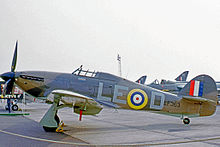
The former Royal Air Force Station Kenley, more commonly known as RAF Kenley was an airfield station of the Royal Flying Corps in the First World War and the RAF in the Second World War. It played a significant role during the Battle of Britain as one of the three RAF stations specifically tasked with the defence of London. It is located near Kenley on the edge of Greater London. The site remains in use with the Ministry of Defence, as Kenley Airfield.

Group Captain Sir Douglas Robert Steuart Bader, was a Royal Air Force flying ace during the Second World War. He was credited with 22 aerial victories, four shared victories, six probables, one shared probable and 11 enemy aircraft damaged.
The Big Wing, also known as a Balbo, was an air fighting tactic proposed during the Battle of Britain by 12 Group commander Air Vice-Marshal Trafford Leigh-Mallory and Acting Squadron Leader Douglas Bader. In essence, the tactic involved meeting incoming Luftwaffe bombing raids in strength with a wing-shaped formation of three to five squadrons. In the Battle, this tactic was employed by the Duxford Wing, under Bader's command.
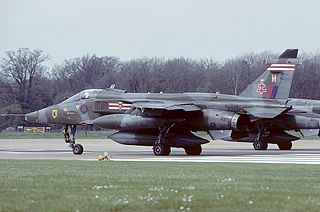
Royal Air Force Coltishall, more commonly known as RAF Coltishall, is a former Royal Air Force station located 10 miles (16 km) North-North-East of Norwich, in the English county of Norfolk, East Anglia, which operated from 1938 to 2006.
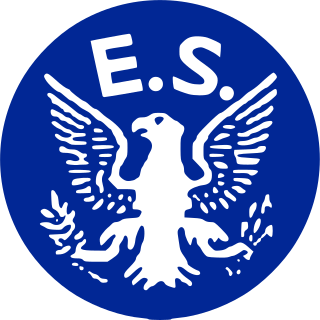
The Eagle Squadrons were three fighter squadrons of the Royal Air Force (RAF) formed with volunteer pilots from the United States during the early days of World War II, prior to America's entry into the war in December 1941.

No. 303 Squadron RAF, also known as the 303rd "Tadeusz Kościuszko Warsaw" Fighter Squadron, was one of two Polish squadrons that fought during the Battle of Britain along with No. 302 Squadron, of 16 total Polish squadrons in the Royal Air Force (RAF) during the Second World War. Flying Hawker Hurricanes, the squadron claimed the largest number of aircraft shot down of the 66 Allied fighter squadrons engaged in the Battle of Britain, even though it joined the fray two months after the battle had begun.

133 Squadron RAF was one of the famous Eagle Squadrons formed from American volunteers serving with the Royal Air Force (RAF) during the Second World War.

No. 310 Squadron RAF was a Czechoslovak-manned fighter squadron of the Royal Air Force in the Second World War.

No. 312 Squadron RAF was a Czechoslovak-manned fighter squadron of the Royal Air Force in the Second World War.

No. 302 Polish Fighter Squadron RAF was a Polish fighter squadron formed in Great Britain as part of an agreement between the Polish Government in Exile and the United Kingdom in 1940. It was one of several Polish fighter squadrons fighting alongside the Royal Air Force during World War II.

Duxford Aerodrome is located 8 nautical miles south of Cambridge, within the civil parish of Duxford, Cambridgeshire, England and nearly 1-mile (1.6 km) west of the village. The airfield is owned by the Imperial War Museum (IWM) and is the site of the Imperial War Museum Duxford and the American Air Museum.

Army Aviation Centre (AAC) Middle Wallop is a British Army airfield located near the Hampshire village of Middle Wallop, used for Army Air Corps training. The base hosts 2 (Training) Regiment AAC and 7 (Training) Regiment AAC under the umbrella of the Army Aviation Centre. 2 (Training) Regiment performs ground training; 7 (Training) Regiment trains aircrew on AAC aircraft after they complete basic training at RAF Shawbury.
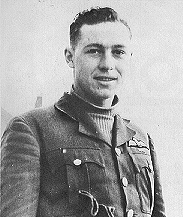
William Lidstone McKnight, was a Canadian aviator and flying ace of the Second World War. He was Canada's fifth-highest scoring ace of the war. McKnight joined the Royal Air Force (RAF) in early 1939 and served in No. 242 Squadron RAF during the final phase of the Battle of France, covering the Allied retreat from Brittany, and later the Battle of Britain.
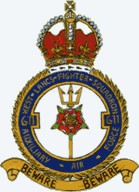
No. 611 Squadron is a British Royal Air Force squadron. It was first formed in 1936 and was disbanded in 1957 after seeing combat as a fighter unit during the Second World War. It was reformed as a reserve squadron in 2013.

426 Transport Training Squadron is a unit of the Canadian Forces under Royal Canadian Air Force, located at CFB Trenton in Trenton, Ontario. It originated as a squadron in the Royal Canadian Air Force (RCAF) that fought during the Second World War as a bomber squadron.
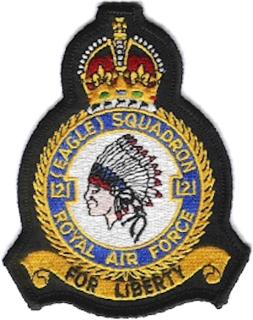
No. 121 Squadron was a Royal Air Force (RAF) aircraft squadron that during the Second World War was one of the three Eagle Squadrons manned by American volunteers. The squadron today is part of the Royal Air Force Air Cadets in Nuneaton.
No. 229 Squadron RAF was a squadron of the Royal Air Force, and is an officially accredited Battle of Britain Squadron. It became No. 603 Squadron RAF in January 1945.

602 Squadron is a Royal Auxiliary Air Force squadron. Originally formed in 1925 as a light bomber squadron, its role changed in 1938 to army co-operation and in 1939 to that of a fighter squadron.

No. 401 Tactical Fighter Squadron, a.k.a. "City of Westmount" Squadron, is a Royal Canadian Air Force squadron based at CFB Cold Lake. During World War II it was a fighter squadron and is notable for having fought in the Battle of Britain. Postwar, the squadron operated in Canada as an auxiliary squadron, reserve squadron and a helicopter and training squadron. In 2015 it was reactivated as a Tactical Fighter Squadron.
Richard John Cork, was a fighter ace in the Fleet Air Arm of the Royal Navy during the Second World War. Cork served in the Battle of Britain as the wingman for Douglas Bader of No. 242 Squadron RAF. When he returned to the Fleet Air Arm in 1941, Cork served with 880 Naval Air Squadron in the Arctic, Mediterranean and Indian Ocean. It was during Operation Pedestal in 1942 that he became the only Royal Navy pilot to shoot down five aircraft in one day, and was the leading naval ace using the Hawker Hurricane. He was given command of the 15th Naval Fighter Wing aboard HMS Victorious before being killed in a flying accident over Ceylon in 1944.
